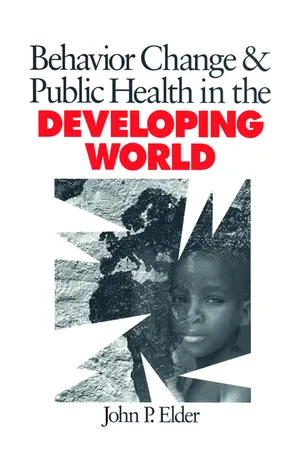
- 192 pages
- English
- PDF
- Available on iOS & Android
Behavior Change and Public Health in the Developing World
About this book
"This is a highly readable and very interesting book that opens a new chapter in thinking about international health form a public health perspective. It makes a compelling case for not only understanding the health problem but the health context. This means looking at policies and politics that are upstream from where the problem is typically addressed. This book will give a new and clear direction to teaching and responding to public health issues in developing countries. It is chock full of examples that illustrate the important principles, values, and lessons that are nicely elaborated in the book. For anyone interested in making a difference in the public health of the developing world, this book will be a vital resource."
—Lawrence Wallack, Portland State University
"This excellent text is targeted to those with little international experience and those unfamiliar with social and behavioral approaches to enhancing public health. The book clearly explicates social and behavioral approaches to resolving health problems in global terms."
—Noreen M. Clark, PhD, University of Michigan School of Public Health
"John Elder pulls together the story of communication and public health. This book will be a unique guide for both health professionals, and communication students to the ideas and programs that have shaped the past thirty years. It goes beyond the story of advertising and campaigns and exposes the real contribution of social marketing and social advocacy to some of the biggest public health success stories of our time." —William Smith, Academy for Educational Development, Washington, D.C.
This volume emphasizes experience in behavior change programs for the prevention and control of the world?s biggest killers: malnutrition, respiratory infections, diarrhea, vaccine-preventable diseases, wasteful fertility, HIV/AIDS, and tobacco use. These programs are linked to theories and models that most typically frame them: health communications and social marketing, learning theory, media advocacy, and community self-control. Descriptions of programs and related literature presented in the book were selected essentially for how well they represent the application of a theory to a specific health or disease target.
Frequently asked questions
- Essential is ideal for learners and professionals who enjoy exploring a wide range of subjects. Access the Essential Library with 800,000+ trusted titles and best-sellers across business, personal growth, and the humanities. Includes unlimited reading time and Standard Read Aloud voice.
- Complete: Perfect for advanced learners and researchers needing full, unrestricted access. Unlock 1.4M+ books across hundreds of subjects, including academic and specialized titles. The Complete Plan also includes advanced features like Premium Read Aloud and Research Assistant.
Please note we cannot support devices running on iOS 13 and Android 7 or earlier. Learn more about using the app.
Information
Table of contents
- Cover
- Contents
- Series Editor's Introduction
- Preface
- Acknowledgments
- Chapter 1 - Health Behavior in the Developing World
- Background
- A Brief History of the Discipline of Public Health
- The Global Burden of Disease
- The Universality of Health Behavior
- Epidemiology and Health Psychology
- The Roots of Behavioral Epidemiology
- Magnitude of Effect
- The Jakarta Declaration
- Summary
- Further Reading
- Chapter 2 - A Few Good Theories—and Behavioral Interventions That Work
- Health Communications and Social Marketing
- The Health Communication and Social Marketing Process
- Learning Theory
- Skill Versus Performance Deficits
- Media Advocacy
- Media Advocacy in Action: Promoting Environmentally Friendly Behaviors in Philippine Fisheries
- Community Self-Control
- Summary
- Further Reading
- Chapter 3 - Nutrition
- Breast-Feeding
- Growth Monitoring
- Nutritional Interventions
- The International Fight Against Formula Feeding
- Other Interventions to Promote Breast-Feeding
- Contingency Management in the Philippines
- Community Self-Control in Indonesia
- Health Communication and Social Marketing in West Africa
- Summary
- Further Reading
- Chapter 4 - Family Planning
- Family Planning Interventions
- Policy-Based Behavior Modification
- The Promotion of Family Planning
- Equality Issues
- Summary
- Further Reading
- Chapter 5 - Infectious Diseases
- Interventions
- Vaccine-Preventable Diseases
- Diarrheal Diseases
- Acute Respiratory Infections (ARIs)
- Tuberculosis
- Vector Control
- Summary
- Further Reading
- Chapter 6 - HIV/AIDS
- Interventions
- Community Self-Control
- Health Communication
- Condom Provision and Communication
- Summary
- Further Reading
- Chapter 7 - Tobacco Control
- The Epidemiological Picture Today
- Environmental and Economic Impact
- Tobacco-Control Interventions
- Summary
- Further Reading
- Chapter 8 - Taking on the Wheel of Disease: Health Behavior Change in the 21st Century
- Consumption
- Energy
- Food
- Medical Care
- Equality
- Equal Opportunity Infections
- Population
- The Interaction Between Inequality and Consumption
- The Interaction Between Population and Consumption
- The Interaction Among All Wheel Components
- The Crux of the Argument: "Risk Factorology" Versus "Public Health Nihilism"
- New Targets for Behavior Change
- Agrodiversity
- Sustainable Consumption
- Conclusions: New Directions for Public Health Promotion
- Summary
- References
- Name Index
- Subject Index
- About the Author